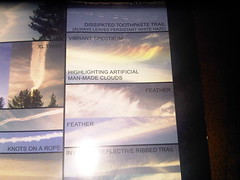In the wake of the realization that climate change is a reality, a geoengineering technology incorporating the use of artificial trees to remove carbon dioxide from the atmosphere is a clear indication that “God is great, beer is good, and people are crazy”. Geoengineering is defined as “climate engineering, climate remediation, and climate intervention” .(1) Geoengineering has been used primarily to refer to “the deliberate large-scale intervention in the Earth’s climate system, in order to moderate global warming“. It typically involves efforts to rid the atmosphere of greenhouse gases, such as carbon dioxide and solar radiation management techniques to “offset effects of increased greenhouse gas concentration by causing the Earth to absorb less solar radiation“. (2)
It has been noted that scientists at Columbia University’s Earth Institute are working on a “carbon capture” project, which involves the use of a prototype of artificial trees that will remove carbon dioxide from the air “faster and at higher levels than natural photosynthesis can accomplish”. (3) This group postulates that the captured carbon dioxide then can be released by a “gentle flow of water” and then can be used industrially or safely sequestered underground. Many environmentalists take an exception to technological fixes for global warming, such as these because such actions “discourage us from the hard work of actually cutting down on greenhouse emissions”. The main consideration here is whether the goal here is climate manipulation or solutions to address climate change.
The reality here is that trees are not the culprits in this scenario. They consistently have done their job well. They effectively reflect the “greatness of God“. It is man who has disrupted this process by actions that increase our carbon footprint, namely pollution of land, air and water, reliance on fossil fuels, and to a large extent, deforestation. Consideration of ethics and moral responsibility is a very valid approach to this issue. Followers of the green movement recognize themselves as “stewards” of the Earth. We have a duty to protect the environment and to pass on a healthy world to future generations. This notion of benevolent management of the world has a foundation in religion, ethics and morality and must not be diminished by greed, politics or sheer lack of responsibility.
Now on to the role of beer (which is good) and its relationship to the idea of artificial trees, in particular, and geoengineering, in general. So many of us are caught up in a rat race. You have to admit that when you take a break with an ice-cold beer, the stress level goes down and you can reflect on life. Now you can appreciate a tree as opposed to the stressful periods when you “couldn’t see the forest for the trees”. Things start to make sense. You realize that so many things about life have become artificial, and maybe we should stop this nonsense.
Finally, the acceptance of artificial trees clearly would indicate that people are crazy. By definition, artificial means “humanly contrived, often on a natural model, manmade, simulated; sham” Already we rely on so many artificial products and ingredients which ultimately bear heavy costs in terms of money, waste, and adverse health consequences. Now trees? To this notion, we must say a resounding NO. We can grow trees with seeds made by trees. We do not need to manufacture them artificially.
We can address climate change by a consolidated effort to avoid pollution, recycling, reducing our fuel and energy consumption and living responsibly. We do not want climate manipulation. Rather, we demand climate change solutions. We want to live green, be green.
Sources for this article:
1. United States Government Accountability Office (GAO) (July 2011) (PDF). Climate Engineering: Technical Status, Future Directions, and Potential Responses (Report). Center for Science, Technology, and Engineering. p. 3. Retrieved 2011-12-01.
2. Royal Society (September 2009) (PDF). Geoengineering the Climate: Science, Governance and Uncertainty (Report). p. 1. ISBN 978-0-85403-773-5. Retrieved 2011-12-01.
3. http://www.huffingtonpost.com/richard-schiffman/artificial-trees-carbon-capture_b_2728083.html.
4. Credit to Bill Currington from song “People Are Crazy”.
Related articles
- World Economic Forum Raises Concerns About ‘Rogue’ Geoengineering (naturalrain.wordpress.com)



